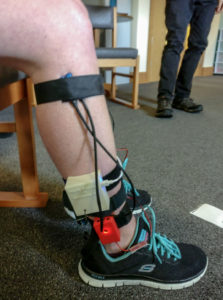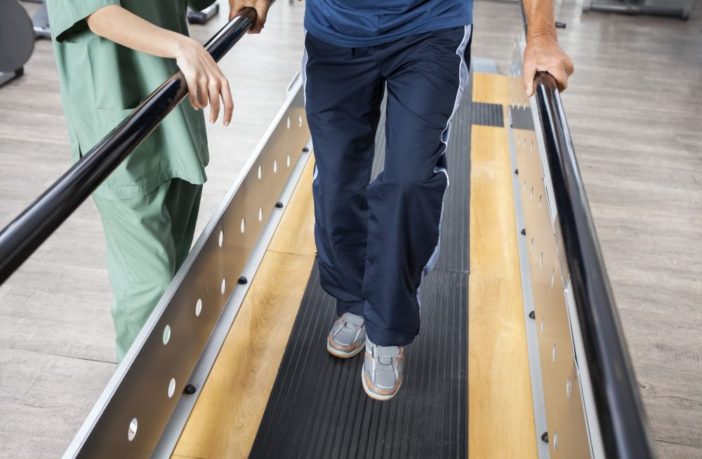A case study conducted by The Open University (OU) has found that wearable haptic devices – technology similar to a mobile phone vibrating at a set rhythm – could improve the mobility of people living with Huntington’s Disease.

Care home patient wearing the haptic device
OU PhD student Riasat Islam and former OU PhD student Dr Theodoros Georgiou, used haptic rhythmic cueing – walking cued by an external, haptic rhythm administered using a wearable device – to stimulate movement in a care home resident living with Huntington’s Disease.
A research-first, haptic rhythmic cueing has been used to rehabilitate people suffering with brain injury and recovering from stroke but never on people living with Huntington’s.
Riasat Islam, Open University PhD student, said:
“Our novel technique has previously shown promising results with stroke and brain injury survivors, and we believe that it can help people with other neurological and neurodegenerative conditions to potentially lead a better quality of life.”
Study shows signs of hope
Research findings are promising as the patient showed an improvement in their gait coordination and limb control. Although this was performed on a small sample size and needs further investigation, it does offer hope to people living with the disease. While this is not a cure, therapeutic outcomes may delay the onset or severity of symptoms.
Dr Georgiou, Research Associate at Heriot-Watt University, said:
“We are pleased to see our approach of using haptic rhythms for rehabilitation successfully extending beyond the initial scope of brain injury and stroke survivors, potentially extending periods of independent mobility for people with incurable conditions such as Huntington’s Disease.”
Dr Simon Holland, Senior Lecturer in Computing at The Open University and supervisor on the study, added:
“This is the first time anyone has used haptic cueing with Huntington’s Disease, which is a terrible condition, and where any alleviation would help. It is also the first such use of this research – having previously moved out of the lab into community situations – in the context of a residential care home.”
The study, partly funded by the Goldcrest Charitable Trust, was conducted in 2018 and since then the team have undertaken further research in this area with a larger sample size on people living with multiple sclerosis, Huntington’s Disease and those recovering from stroke and brain injury to validate their findings.
For more on the study, read the paper published in JMIR Rehabilitation and Assistive Technologies.



